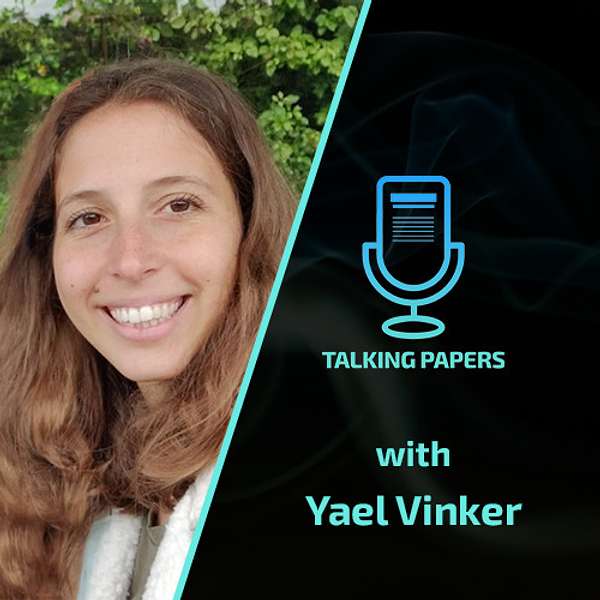
Talking Papers Podcast
🎙️ Welcome to the Talking Papers Podcast: Where Research Meets Conversation 🌟
Are you ready to explore the fascinating world of cutting-edge research in computer vision, machine learning, artificial intelligence, graphics, and beyond? Join us on this podcast by researchers, for researchers, as we venture into the heart of groundbreaking academic papers.
At Talking Papers, we've reimagined the way research is shared. In each episode, we engage in insightful discussions with the main authors of academic papers, offering you a unique opportunity to dive deep into the minds behind the innovation.
📚 Structure That Resembles a Paper 📝
Just like a well-structured research paper, each episode takes you on a journey through the academic landscape. We provide a concise TL;DR (abstract) to set the stage, followed by a thorough exploration of related work, approach, results, conclusions, and a peek into future work.
🔍 Peer Review Unveiled: "What Did Reviewer 2 Say?" 📢
But that's not all! We bring you an exclusive bonus section where authors candidly share their experiences in the peer review process. Discover the insights, challenges, and triumphs behind the scenes of academic publishing.
🚀 Join the Conversation 💬
Whether you're a seasoned researcher or an enthusiast eager to explore the frontiers of knowledge, Talking Papers Podcast is your gateway to in-depth, engaging discussions with the experts shaping the future of technology and science.
🎧 Tune In and Stay Informed 🌐
Don't miss out on the latest in research and innovation.
Subscribe and stay tuned for our enlightening episodes. Welcome to the future of research dissemination – welcome to Talking Papers Podcast!
Enjoy the journey! 🌠
#TalkingPapersPodcast #ResearchDissemination #AcademicInsights
Talking Papers Podcast
CLIPasso - Yael Vinker
In this episode of the Talking Papers Podcast, I hosted Yael Vinker. We had a great chat about her paper "CLIPasso: SEmantically-Aware Object Sketching”, SIGGRAPH 2022 best paper award winner.
In this paper, they convert images into sketches with different levels of abstraction. They avoid the need for sketch datasets by using the well-known CLIP model to distil the semantic concepts from sketches and images. There is no network training here, just optimizing the control points of Bezier curves to model the sketch strokes (initialized by a saliency map). How is this differentiable? They use a differentiable rasterizer. The degree of abstraction is controlled by the number of strokes. Don't miss the amazing demo they created.
Yael is currently a PhD student at Tel Aviv University. Her research focus is on computer vision, machine learning, and computer graphics with a unique twist of combining art and technology. This work was done as part of her internship at EPFL
AUTHORS
Yael Vinker, Ehsan Pajouheshgar, Jessica Y. Bo, Roman Bachmann, Amit Haim Bermano, Daniel Cohen-Or, Amir Zamir, Ariel Shamir
ABSTRACT
Abstraction is at the heart of sketching due to the simple and minimal nature of line drawings. Abstraction entails identifying the essential visual properties of an object or scene, which requires semantic understanding and prior knowledge of high-level concepts. Abstract depictions are therefore challenging for artists, and even more so for machines. We present an object sketching method that can achieve different levels of abstraction, guided by geometric and semantic simplifications. While sketch generation methods often rely on explicit sketch datasets for training, we utilize the remarkable ability of CLIP (Contrastive-Language-Image-Pretraining) to distil semantic concepts from sketches and images alike. We define a sketch as a set of Bézier curves and use a differentiable rasterizer to optimize the parameters of the curves directly with respect to a CLIP-based perceptual loss. The abstraction degree is controlled by varying the number of strokes. The generated sketches demonstrate multiple levels of abstraction while maintaining recognizability, underlying structure, and essential visual components of the subject drawn.
RELATED PAPERS
📚CLIP: Connecting Text and Images
📚Differentiable Vector Graphics Rasterization for Editing and Learning
LINKS AND RESOURCES
📚 Paper
💻Project page
SPONSOR
This episode was sponsored by YOOM. YOOM is an Israeli startup dedicated to volumetric video creation. They were voted as the 2022 best start-up to work for by Dun’s 100.
Join their team that works on geometric deep learning research, implicit representations of 3D humans, NeRFs, and 3D/4D generative models.
Visit YOOM.com.
CONTACT
If you would like to be a guest, sponsor or share your thoughts, feel free to reach out via email: talking.papers.podcast@gmail.com
🎧Subscribe on your favourite podcast app: https://talking.papers.podcast.itzikbs.com
📧Subscribe to our mailing list: http://eepurl.com/hRznqb
🐦Follow us on Twitter: https://twitter.com/talking_papers
🎥YouTube Channel: https://bit.ly/3eQOgwP
